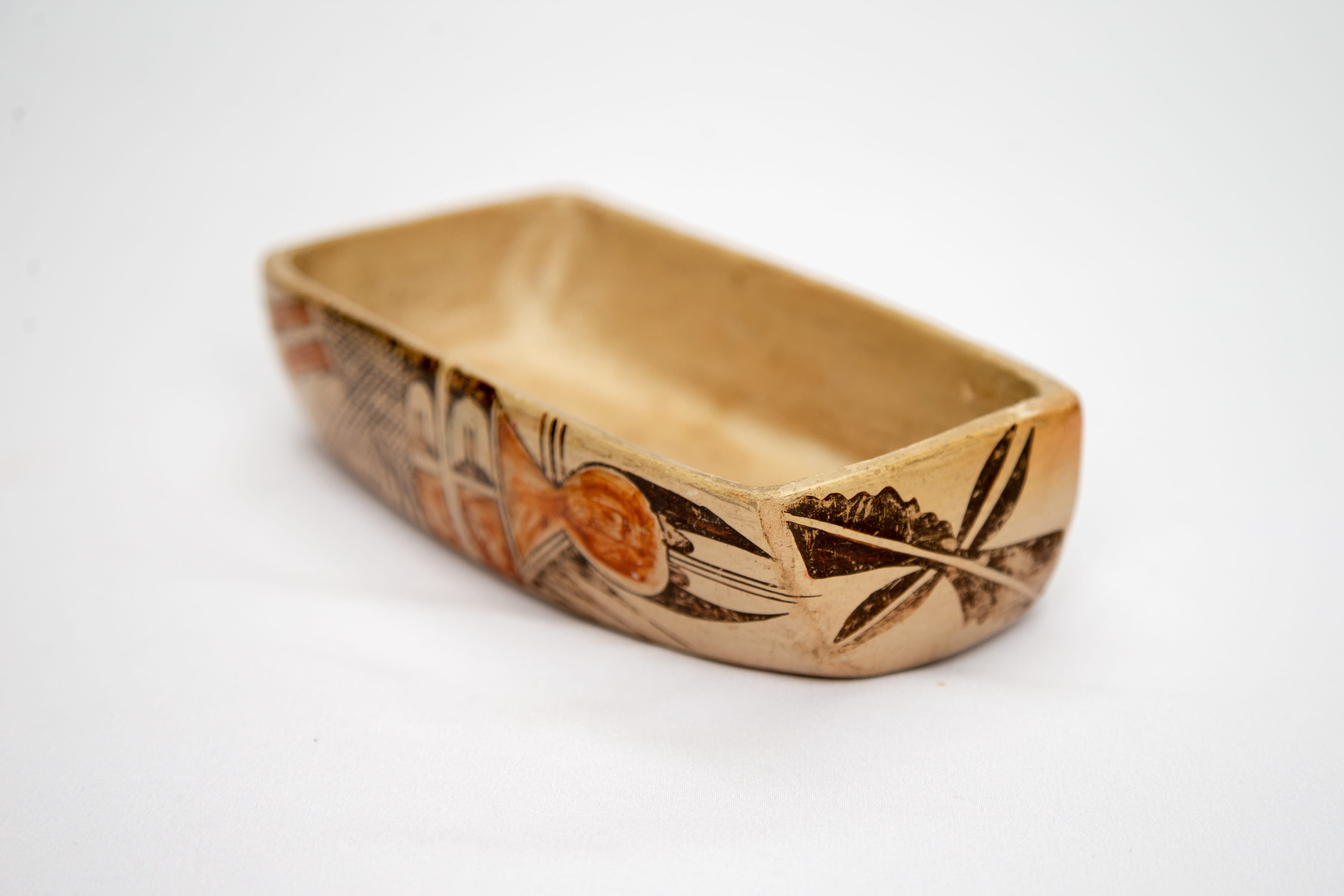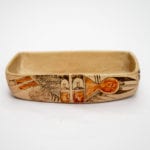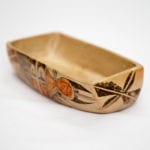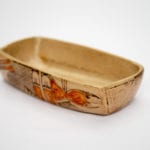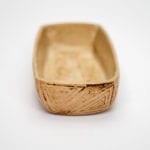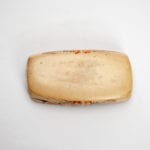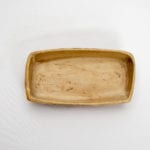This is one of those pots that I wish could talk to me and explain itself..
It has the size and shape of a bowl used in Hopi ritual, but is probably too decorated for that use. The interior design is so worn that its pattern is speculative. The exterior design looks like an insect to me, but this seems to be the only example known so that’s just a guess. There’s a good chance the bowl might have been made and painted by Nampeyo, but without a comparative example I cannot be sure. Thus my discussion of bowl 2017-15 can only be suggestive. I know what it looks like, but I don’t know what it is.
The walls of 2017-15 are substantial but not thick. The bottom is slightly convex. The surface is smooth and well-polished. The pot was evenly- fired with no apparent blush.
All four external walls of the rectangle are painted as was the interior bottom of the pot. One end painting is substantially worn. The interior design is substantially obliterated.
The worn design on one end is composed of two interlocked triangular spirals representing the Ho-bo-bo (Twister) spiral formed into a triangle. According to Alexander M. Stephen (Patterson, 1994: 27-29) Ho-bo-bo is is the source of wind, keeper of the breath. This element is said to represent the eddies of water that form at the entrance to Masau’s home near the mouth of the Little Colorado river in the Grand Canyon. Masau granted permission for people to inhabit this Fourth World of the Hopi and is thus the giver of life. He is also the god of death. The other end of the rectangle is painted with two elements intersecting to form an X-shaped design. Each axis has an imbedded unpainted strip, thus cleaving the design in half. One axis is symmetrical and is formed of two coffee bean shaped elements: hills with their bases facing each other. The other axis of the X is a bit more complicated. One element is the diagonal half of a rectangle; the other is of roughly the same shape, but with its edges notched into a series 6 or 7 steps. These two rectangular variations face each other across the unpainted median, together creating a leaf-like form.
The designs on the long sides of the box are identical, though so complex that their image is worth more than a thousand words. This is an abstract form that seems to me to be an insect, though that might not have been the intention of the painter. This is the only example of this design known to me, so I have no previous analysis for comparison. The upper torso, neck and head of the creature are solid red: a oval head set on a triangular base. Crowning the head are two solid-black pinchers for seizing prey. At the inside base of the pinchers are two small black triangles. Between these triangles are three thin parallel lines, forming a tongue that looks like two-lane highway.
Behind the neck are two identical designs separated from the front and each other by narrow, unpainted strips. The botom of this design is a simple red rectangle, above it –again separated by one of those narrow unpainted strips– is a black design. The top of this section is a black arch. On the base of the unpainted area below is a low black gumdrop shape with two parallel lines emerging from its apex. Towards the rear of the creature is a large oddly-shaped cross-hatched area roughly in the form of a triangle with the center of one side ballooned out into a circle. Exactly 21 horizontal lines fill this portion of design, crossed by 21 slanted lines to form a pattern of diamonds. While this crosshatched design is more carefully drawn on one side than the other, the number of intersecting lines is exactly the same on both sides. This artist was counting. Similar crosshatching can be seen on Nampeyo’s Un-tok-ina serpent bowl, 2020-11.
On either side of the triangle emerging from the rounded crosshatch are two-lane highway elements that lay flat against the crosshatching. Emerging from the bottom highway are three black triangles forming a sawtooth. Emerging from the highway above the triangle are two red feathers with black tips. These tip on one feather is more worn than the tip of the other.
Finally there is a faint monochromatic design about 5-inches long on the bottom interior of the bowl. The design seems fairly symmetrical but is not centered. It consists of two torpedo-shaped elements, each with a black head that is indistinct on one rendition and entirely worn off (and therefore presumed) on the other. Because the design is not centered, there is substantial space between one of the torpedo designs and the wall of the vessel. About 1.75 inches behind the head of this design, a 2-inch black fin emerges angling toward the rear and reaching almost to the interior wall. A similar but shorter black fin angling in the opposite direction emerges from the second torpedo about 1.5 inches from its rear. The last 1.5 inches of each torpedo consists of a linear tail feather. Each feather is set on the familiar single-lane highway, followed by the same wiskered gumdrop seen on the exterior design. The unpainted core of each feather terminates with a black tip with a rounded end. This tip is more worn on one rendition than the other. An artist friend, Edward Lane McCartney, looked at this design under magnification and drew a) what he saw, and b) what he imagined the complete interior design might look like. Those drawings are presented here.
[columns][one-half] [/one-half][one-half]
[/one-half][one-half]  [/one-half][/columns] Imagined Saw
[/one-half][/columns] Imagined Saw
Why the interior design is so worn while the exterior design remains intact is one of the mysteries of this pot. Perhaps the heat of the firing did not fully reach the interior and the design was not well fixed to the pot’s surface and was therfore never clear. Perhaps the pot had ritual use and items were put in it that wore the surface, though one would then expect more wear to the exterior design as the pot was handled. Perhaps it sat on a tourist’s desk for years filled with paper clips that wore away the design. Add your own guess here: _______.
In Appendix B I defined six characteristics of Nampeyo’s Sikyatki Revival style. I apply these standards to any pot I am analyzing to judge if it was made by Nampeyo or not.
When pot 2017-15 is tested against these standards, I find that:
- A tension between linear and curvilinear elements, often represented as a contrast between heavy and delicate elements.
The pinchers and head of the insect are curvalinear. Three parallel lines rising from the neck and the sides of the triangle provide nearby linear tension. The two linear tails at the rear of the creature contrast with the the bulbous curved crossharch area below them.
2) A deliberate asymmetry of design.
All of the designs on this retangular pot are asymmetric. Most obviously (were the design clear), the interior design is radically thrown off balance by the two black fins pointing in opposite directions. While the layout of the Ho-bo-bo pattern is balanced, its execution is not. The top spiral is larger than the bottom
3) The use of color to integrate design elements.
The end designs are monochromatic, but the design on the long sides uses color to integrate the design. The red of the front end of the design is mostly red. The two linear tails at the rear are also red, thus attracting the viwer’s eye to the full range of design and intigrating it.
4) The use of empty (negative) space to frame the painted image.
There is no negative space on the exterior of bowl 2017-15. Given the 6″ by 1.5″ strip within which to paint, the artist choices of layout were constrained. The design fills the available space. (This same constraint of space and resulting pattern of design is also seen on the exterior on 2017-04, a rectangular pot by Nampeyo.) From what can be discerned of the faded interior design on of bowl 2017-15 the design does seem to be flanked by substantial empty space that would highlight the design were it more visable.
5) The use of a thick above a thin framing line on the interior rim of her bowls.
Apparently Nampeyo did not treat rectangular “bowls” the same as she did the normal round ones. Rectangular tray 2017-04 by Nampeyo also lacks framing lines.
6) Confident, bold, and impulsive painting.
As I always note, this is the most importasnt but also the most subjective of criteria in determing whether Nampayo was the painter. To my eye, the painting on bowl 2017-15 is confident and bold. The painter fit a lot of design into a small space, but the layout is not frenzied though it is crowded. The drawing is thoughtful (exactly 21 by 21 lines form the crosshatching on both sides of the bow) but also impulsive (the four sets of 21 lines vary in their distance from each other but do not touch or cross.). Other Hopi-Tewa and Hopi potters may use similar designs, but none has the same brushwork as Nampeyo.
The conclusion that a pot is “by Nampeyo” because its painting is ” confident, bold, and impulsive” is subjective because it is based on how my eye memory evaluates Nampeyo’s brushwork. To evaluate my eye, I invite the viewer to train their own eyes by reviewing 6 design elements that appear on rectangular bowl 2017-15 and compare them to the same design elements on other Nampeyo pots in this collection. Of course you might look for these same elements on published Nampeyo pots, particularly in Collins, 1974, Cusick, 1984, Kramer, 1996, Struver, 1996, Blair, 1999 and Wade and Cooke, 2012. Having reviewed this material you can make your own judgement about the painter of this pot.
Six design elements that are used on pot 2017-15 also appear on other Nampeyo pots in this collection:
a) The linear tails with rounded ends were a favorite design element of Nampeyo. Some renditions are exactly like those found on pot 2017-15, others are variations: See pots 1993-04, 1996-05, 1999-03, 2002-03, 2005-16, 2006-02, 2012-21, 2013-03, 2014-07, 2014-20, 2015-11, 2015-12 and 2017-04, all by Nampeyo and all in this collection.
b) Bifurcated cloud elements (“coffee beans”) are used on pots 1993-04, 2006-02, 2008-06, 2011-16, 2012-13, 2012-25, 2014-17 and 2014-20, all by Nampeyo and all in this collection.
c) Parallel lines (“highways”) are used on pots 1993-04, 1999-03, 2009-10, 2011-16, 2013-03, and 2012-25, all by Nampeyo and all in this collection.
d) A sawtooth design is used on 2006-11, 2009-10, 2012-13, 2012-25, 2015-04 and 2015-11, all by Nampeyo and all in this collection.
e) Triangular spirals representing the Ho-bo-bo are used with variations on 1993-04, 2009-08, 2009-10 and 2012-02, all by Nampeyo and all in this collection.
f) Convex forms with parallel lines (“gumdrops with whiskers”) are used on pots 1999-03, 2013-03 and 2014-20, all by Nampeyo and all in this collection.
The accumulation of this evidence leads me to conclude that rectangular bowl 2017-15 was probably made by Nampeyo. I am intrigued enough by this pot that I carried it around the southwest for two weeks and took it with me when I visited Ed Wade and his wife Carol in their home 8-29 to 30-18. “The split coffee-bean elements on the ends and the crossing split leaf patterns are common on Nampeyo pottery,” Ed noted. “I have not seen the full ‘bug’ image on the sides of the bowl before, but the body behind the head is composed of classic Nampeyo motifs. Particularly the cross-hatached area with the protruding section and the emerging two red tails are characteristic of her hand.” Ed also noticed the worn interior image of the bird and said that this was odd. “It’s seems like the bowl has been used for some purpose and the design wore away,” he commented.
Although I also do not know of a similar bug design on another Nampeyo pot (or any other pot), given my detailed discussion and Ed’s comments, I am listing this pot as “by Nampeyo.”
Rectangular Hopi bowls are rare but not unknown. Fewkes (1898, plate CXXVIII following page 668 or reprinted, 1973: 44 ff) illustrates a “medicine box” (“c”) from Sikyatki which is of similar shape to bowl 2017-15 and is also decorated on the exterior. Fewkes writes about this bowl that the “several (Sikyatki) rectangular receptacles of earthenware” he excavated “are regarded as medicine bowls, and are supposed to have been used in ancient ceremonials where asperging was performed. In many Tusayan ceremonials square medicine bowls, some without handles, are still used, but a more common and evidently more modern variety are round and have handles.” Fewkes then mentions a “rectangular or ancient type of medicine bowl” used on the Antelope clan altar for the snake dance at Oraibi (Third Mesa) (1898, 681 or 1973 reprint 57).
There are two other rectangular Hopi bowls in this collection. One (1992-11) was likely used in rutual, has no exterior decoration and only slight interior decoration. The other (2017-04) by Nampeyo has already been discussed, but I do not believe it had ritual purpose. Please see entries for those bowls for more detail.
I have said all I know about pot 2017-15; Ed has offered his opinion. Now would be a good time for the pot to speak up.

